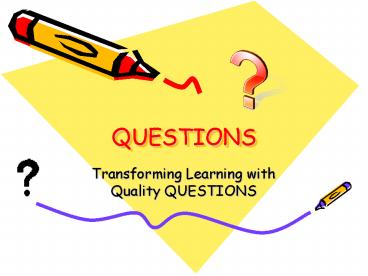QUESTIONS - PowerPoint PPT Presentation
1 / 17
Title:
QUESTIONS
Description:
Without questions the inquiry cycle stops and learning regresses into read and ... Thinking without questions is uninspired, flat, inflexible, unyielding. ... – PowerPoint PPT presentation
Number of Views:94
Avg rating:3.0/5.0
Title: QUESTIONS
1
QUESTIONS
- Transforming Learning with Quality QUESTIONS
2
Questioning and Inquiry
- Questioning is the first element of Information
Inquiry. - Questioning seeds all other processes.
- Without questions the inquiry cycle stops and
learning regresses into read and recite, without
testing for relevance and meaning. -
Daniel Callison
3
Wonder and learn!
- Jamie McKenzie QUESTIONING.ORG
- Questioning is to thinking as yeast is to bread
making. Thinking without questions is
uninspired, flat, inflexible, unyielding.
Questioning converts thinking into something of
value, transforming matter into meaning.
4
Questions and INQUIRY
- Inquiry is not so much seeking the right
answer-because often there is none-bout rather
seeking appropriate resolutions to questions and
issues. - www.thirteen.org
- Inquiry should be motivated by questions whose
purpose, meaning, or relation to the real world
are apparent to the child. - Karen Sheingold
5
Questions are the product of natural curiosity.
- Teachers need to yield the monopoly on the right
to question. - Learners need to be encouraged to ask questions,
to wonder, and to generate new questions as
inquiry proceeds. - Student centered process depends on questions, as
does the authentic construction of meaning from
text. -
Daniel Callison
6
Questioning through inquiry the foundation of
life-long learning
- Student ownership of questioning process leads to
students becoming content experts. - As they continue to probe and explore, students
discover the questions central to the issue at
hand. - Dennis Palmer Wolf
7
Questions as a tool for assessment
- Renovating and revising questions, documented in
journals and logs, gives an important insight to
progress through information selection, analysis,
and synthesis. - Questions help learners identify issues, frame
arguments, and determine what points need more
convincing evidence. - Daniel Callison
8
Types of questions- McKenzie
- Clarification- What was reliable, valid?
- Sorting and Sifting- What is worth keeping?
- Elaborating- What is the logical next step?
- Planning- What has been done or could be done to
address these issues?
9
More types of ????
- Strategic questions- What do I have? What do I
need? What is the best next step? - Unanswerable questions
- Irreverent questions- How can we change this? Can
we trust this? - Wonder questions-Explore boundaries
- Divergent questions- Beyond what we have, what
else might we need or want to know?
10
Another perspective.
- Galileo.org
- HIGHER ORDER
- RICH
- WORTHY
- ESSENTIAL
- FERTILE
- CONNECTED
- CHARGED
- OPEN
- YouthLearn.org
- Factual questions
- Interpretive questions
- Evaluative questions
- Invite opinions, thoughts, feelings
11
WHO? What? Where? When?
- Factual, single right answer questions are only a
starting point. - Moving from trivial to essential questions
engages kids in authentic and meaningful
learning. - Factual questions in a brainstorming exercise can
be used in a concept map. - Factual questions help evaluate comprehension,
help with summary. - Factual questions lead to short term recall and
need expanded context and meaning. - CTAP Region IV
12
WHY? HOW? Should?SO WHAT? Which one? What if?
- BIG QUESTIONS encourage kids to think more deeply
and critically. - BIG questions stimulate students to seek
information on their own. - BIG questions are open, cannot be answered with
yes or no. - BIG questions require multiple resources to be
answered. - BIG questions must be interesting.
- CTAP Region IV
13
Excellent Questions are
- Open-ended
- Have more than one word answer
- Have more than one answer
- Show effort and deep research
- Lead to multiple perspectives
- Lead to debate
- Are interesting, not obvious
- Lead to more questions and thinking
- CTAP Region IV
14
Essential questions
- Probe a matter of considerable importance
- Move a learner from understanding to action
- Are global and abstract
- Go to the heart of what is important to learn and
understand - Lead to enduring truths after the facts have been
forgotten - Endure, shift, lead to larger questions
- Cannot be answered completely or in few words
- Maintain interest despite mystery
- Lead to other questions
- Are asked over and over in the course of the
inquiry - Harada and McKenzie
15
Research Questions
- FOCUS- Does the question focus your research and
include relevant perspectives? - INTEREST- Are you excited about your question?
- KNOWLEDGE- Will the question help you learn?
- PROCESSING- Will the question help you understand
your topic better? - Koechlin/Zwaan
16
Questions as reflections
- Is my project meaningful and interesting?
- Will there be useful resources I can understand?
- Have I read widely in relevant literature?
- Is the information supporting my ideas the most
convincing and meaningful? - What information and search paths were most
useful? Least useful? - What information inspired me or excited me about
what I could report to others? - Violet Harada
17
Teacher Actions
- Model questioning
- Engage learners in sharing questions and
resources - Look for variety of questions and levels of
thinking - Meaning begins with information from text who,
what, where, when. - Reward questioning, display questions
- Promote reading with questions.

